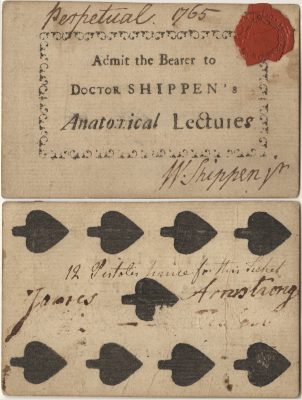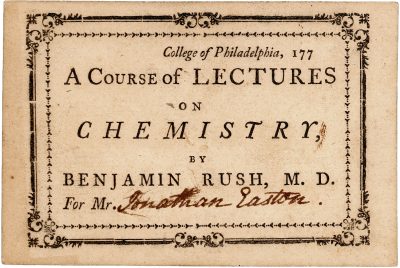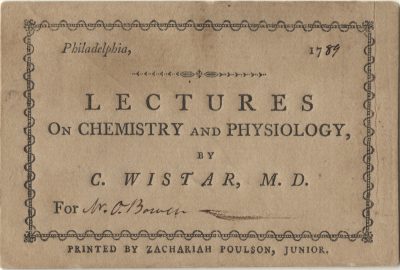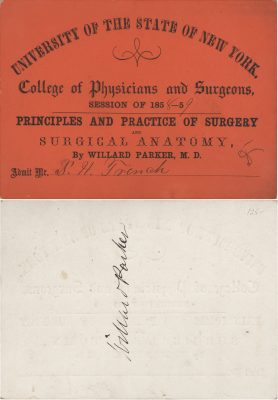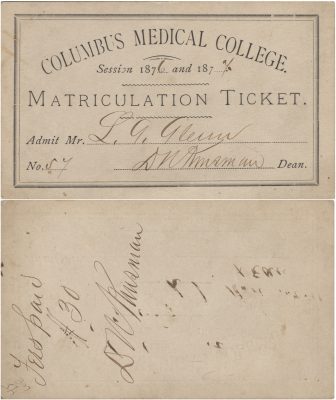9. College of Philadelphia (University of Pennsylvania)
| College of Philadelphia (University of Pennsylvania) 1765 Morgan, John, MD Armstrong, James Materia medica, practice of physic |
|
|
In 1765 Morgan, along with William Shippen, Jr., MD (10) founded the first medical school in North America at the College of Philadelphia, soon known as the University of Pennsylvania. Morgan earned his medical degree at the University of Edinburgh and studied further in Paris before returning to Philadelphia and convincing the Trustees of the College of Philadelphia to establish a medical school. In his famous Discourse upon the Institution of Medical Schools in America, Morgan advocated a systematic and coherent course of instruction, a plan medical education reformers would echo in years to come. He also believed in distinguishing the trades of surgeons and apothecaries from the true physicians. As Penn’s first professor of medicine, Morgan issued this lecture ticket to Armstrong (Penn; M1769), one of America’s first medical students. He handwrote the ticket on the back of an ordinary playing card (five of diamonds) and stamped it with his seal. While Armstrong’s name does not appear on the ticket, accession records connect him with it. Armstrong, of Carlisle, PA, became a medical officer in the Revolutionary War, after which he pursued three years of additional medical study in London.
“Historical Matriculation Cards: Governor Pennypacker Finds Treasures for the University.” Old Penn. Vol. IV, No. 25. March 17, 1906.
James Armstrong. http://archives.dickinson.edu/people/james-armstrong-1748-1828 University of Pennsylvania Archives & Records Center. Penn Biographies, John Morgan (1735-1789). |
|
10. College of Philadelphia (University of Pennsylvania)
| College of Philadelphia (University of Pennsylvania) 1765 Shippen, William Jr., MD Armstrong, James Anatomy |
|
| The College of Philadelphia, forerunner of the University of Pennsylvania, opened in 1765 as the first medical school in North America. That makes this lecture ticket and another issued by John Morgan, MD (9) the nation’s earliest tickets to formal medical education. Shippen obtained his medical degree at the University of Edinburgh and upon returning to Philadelphia in 1762, taught a series of private lectures on anatomy and surgery and a controversial course on midwifery. Three years later he and Morgan established Penn’s medical school with Shippen as professor of anatomy (and eventually surgery and midwifery). During most of the Revolutionary War, Shippen served as Director General of Hospitals. He then returned to the newly reorganized University where he taught until 1806. Shippen printed the 1765 ticket on the back of a nine of spades and sealed it. He wrote, “12 pistoles paid for this ticket.” A pistole was a European gold coin. (For Armstrong, see 9.)
“Historical Matriculation Cards: Governor Pennypacker Finds Treasures for the University.” Old Penn. Vol. IV, No. 25. March 17, 1906.
University of Pennsylvania Archives & Records Center. Penn Biographies, William Shippen, Jr. (1736-1808). |
|
11. College of Philadelphia (University of Pennsylvania)
|
College of Philadelphia (University of Pennsylvania) 1769 Kuhn, Adam, MD Armstrong, James Botany |
|
|
Kuhn pursued his education in Norway and Sweden, where he studied botany under Linnaeus, and in 1767 received his medical degree from the University of Edinburgh. Upon his return to Philadelphia, he became the third faculty member of the Medical Department of the College of Philadelphia and its first professor of materia medica and botany, forerunner of the department of pharmacology. Kuhn later taught theory and practice of medicine. He was a founder and early president of the College of Physicians. On the back of the lecture ticket, Kuhn wrote “Perpetual Ticket,” meaning that Armstrong (Penn; M1769) could return to take his course in the future at no additional charge. (For Armstrong, see 9.)
University of Pennsylvania Archives & Records Center. Penn Biographies, Adam Kuhn (1741-1817).
|
|
12. College of Philadelphia (University of Pennsylvania)
| College of Philadelphia (University of Pennsylvania) c1770 Rush, Benjamin, MD Easton, Jonathan Chemistry |
|
|
After receiving his medical degree in Edinburgh (M1768) and pursuing additional studies in London and France, Rush joined the Penn faculty in 1769. He taught chemistry for 20 years and published the first American text on the subject. He subsequently held the professorships of theory and practice of medicine, and the institutes of medical and clinical medicine. In 1776 he became the only physician to sign the Declaration of Independence. Rush served as surgeon at Pennsylvania Hospital (43, 44, 45) from 1784 until his death. His efforts to work with and humanize the care of psychiatric patients earned his reputation as the “father of American psychiatry.” Easton received a bachelor in medicine in 1771, then upon completion of three years of professional experience and presumably a thesis received a doctorate in 1774. Around this time, he administered the first smallpox inoculations in his native Rhode Island. Easton’s son and namesake later studied under Rush and received his Penn degree (M1810).
Parsons, Usher. Sketches of Rhode Island Physicians. Deceased Prior to 1850. Providence: Knowles, Anthony & Co., 1859. http://archive.org/details/101205374.nlm.nih.gov
University of Pennsylvania Archives & Records Center. Penn Biographies, Benjamin Rush (1746-1813). |
|
13. College of Philadelphia (University of Pennsylvania)
|
College of Philadelphia (University of Pennsylvania) 1789 Wistar, Caspar, MD Bowen, O. Chemistry and physiology |
|
| Wistar received his bachelor of medicine degree in 1782 from the University of the State of Pennsylvania (formed in 1779 and in 1791 merged with the College of Philadelphia to form the University of Pennsylvania) and his doctorate from the University of Edinburgh in 1786. Upon returning to Philadelphia he established a large private practice and in 1788, Penn appointed him professor of chemistry. Wistar later taught anatomy, midwifery and surgery. During Philadelphia’s 1793 yellow fever epidemic, Wistar along with several Penn physicians remained in the city to treat patients while many people fled to the countryside. Prior to the Lewis and Clark Expedition, President Thomas Jefferson sent Lewis Meriwether to visit Wistar for his expertise in medicine and paleontology. Jefferson and Wistar, associated through the American Philosophical Society, assisted Charles Wilson Peale in reassembling skeletons for his museum (42). In 1811 Wistar published A System of Anatomy, the first American textbook on anatomy.
American Philosophical Society. Caspar Wistar Papers, 1794-1817. http://www.amphilsoc.org/mole/view?docId=ead/Mss.B.W76-ead.xml
ExplorePAHistory.com. http://explorepahistory.com/hmarker.php?markerId=1-A-181 University of Pennsylvania Archives & Records Center. Penn Biographies, Caspar Wistar (1761-1818). |
|
College of Physicians and Surgeons, University of the State of New York (Columbia University College of Physicians and Surgeons)
| College of Physicians and Surgeons, University of the State of New York (Columbia University College of Physicians and Surgeons) 1858-59 Detmold, William, MD French, S. (Salphronius) H. Surgical clinique |
|
|
The College of Physicians and Surgeons was incorporated in 1807. In 1830 Detmold, a pioneer orthopedic surgeon, graduated from medical school at the University of Göttingen, in his native Germany. He served as an Army surgeon until immigrating to New York City, where he opened an orthopedic clinic. During the Civil War Detmold assisted in organizing the United States Army Medical Corps and introduced the “Detmold knife,” a combination knife and fork for one-armed men. Columbia University, which adopted the College of Physicians and Surgeons as its Medical Department in 1860, appointed Detmold professor of military surgery and hygiene to prepare medical students for battlefield medicine. He authored a text on the treatment of clubfoot, and was a founder and first president of the New York County Medical Association. (For French, see 1.)
Kelly, Howard A. and Walter L. Burrage. American Medical Biographies. Baltimore: The Norman Remington Company, 1920. 308.
|
|
College of Physicians and Surgeons, University of the State of New York (Columbia University College of Physicians and Surgeons)
| College of Physicians and Surgeons, University of the State of New York (Columbia University College of Physicians and Surgeons) 1858-59 Parker, Willard, MD French, S. (Salphronius) H. Surgery and surgical anatomy |
|
| Parker (Harvard; M1830, Berkshire; M1831), one of New York’s leading mid-19th-century surgeons, taught anatomy and/or surgery at several medical schools before becoming professor of surgery at the College of Physicians and Surgeons in 1840. Parker remained connected with the College for 45 years. He originated the operation for cystotomy for irritable bladder, performed the first successful operation upon an abscessed appendix, and was the first to distinguish concussion of the nerves from concussion of the nerve centers. Parker helped reorganize New York City’s health department and hospital system, transforming Bellevue Hospital from almshouse to charity hospital. He took up the crusade against dipsomania, succeeding Valentine Mott, MD (60) as president of the State Inebriate Asylum. Parker consulted as surgeon to St. Luke’s, Roosevelt and Mt. Sinai Hospitals. New York’s Willard Park Hospital for Contagious Diseases was built and named in his honor. (For French, see 1.)
“Dr. Willard Parker Dead.” The New York Times. April 26, 1884.
Kelly, Howard A. and Walter L. Burrage. American Medical Biographies. Baltimore: The Norman Remington Company, 1920. 883-84. Norwood, William Frederick. Medical Education in the United States before the Civil War. Phila: University of Pennsylvania Press, 1944. 113-124. “Willard Parker (1800-1884), New York Physician and Surgeon.” JAMA. Dec. 5, 1996. Vol. 198, No. 10. 192-93. |
|
16. Columbus Medical College (merged with Starling Medical College of Columbus)
| Columbus Medical College (merged with Starling Medical College of Columbus) 1876-77 Kinsman, D.N., MD (dean) Glenn, L.G. Matriculation ticket |
|
|
This lecture ticket dates from the opening year of Columbus Medical College, which in 1892 merged with Starling Medical College (56). Four professors, including Kinsman (Ohio Medical College; M1863), who resigned from Starling Medical College over a faculty-hiring dispute, started Columbus Medical College. Notably, this new post-Civil War medical school was among the first to sign the articles of confederation of the Association of American Medical Colleges, intended to raise the standard of medical education. Glenn graduated from Columbus Medical College in 1877.
Ohio State University Libraries Blogs. http://library.osu.edu/blogs/mhcb/category/columbus-medical-college/
Sixth Annual Announcement of the Columbus Medical College, Session 1880-81. Columbus, Ohio: Cott & Hann, Job and Book Printeres, 1880. Taylor, William Alexander. Centennial History of Columbus and Franklin County, Ohio. Vol. 1. S.J. Clarke Publishing Company, 1909. 69. |
|


